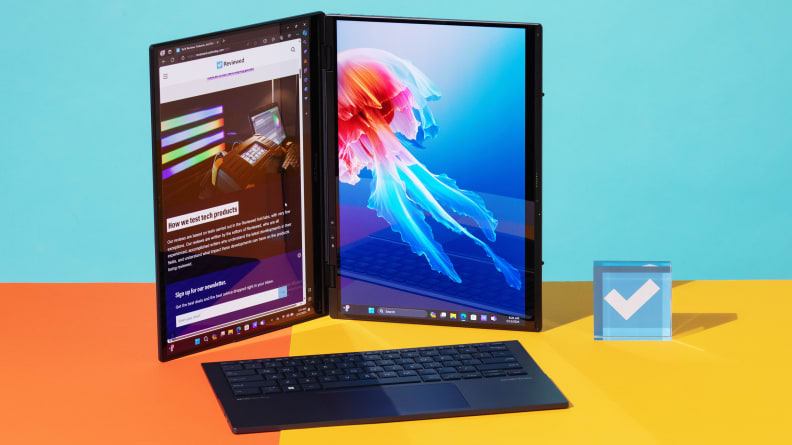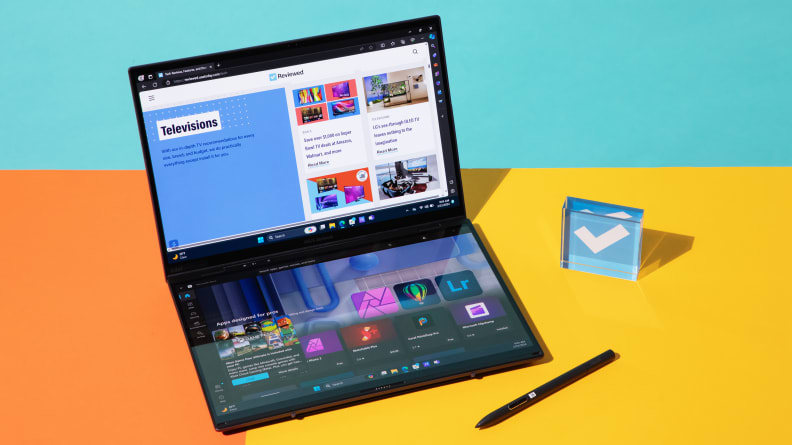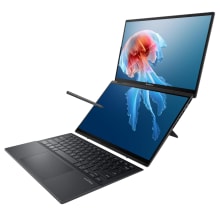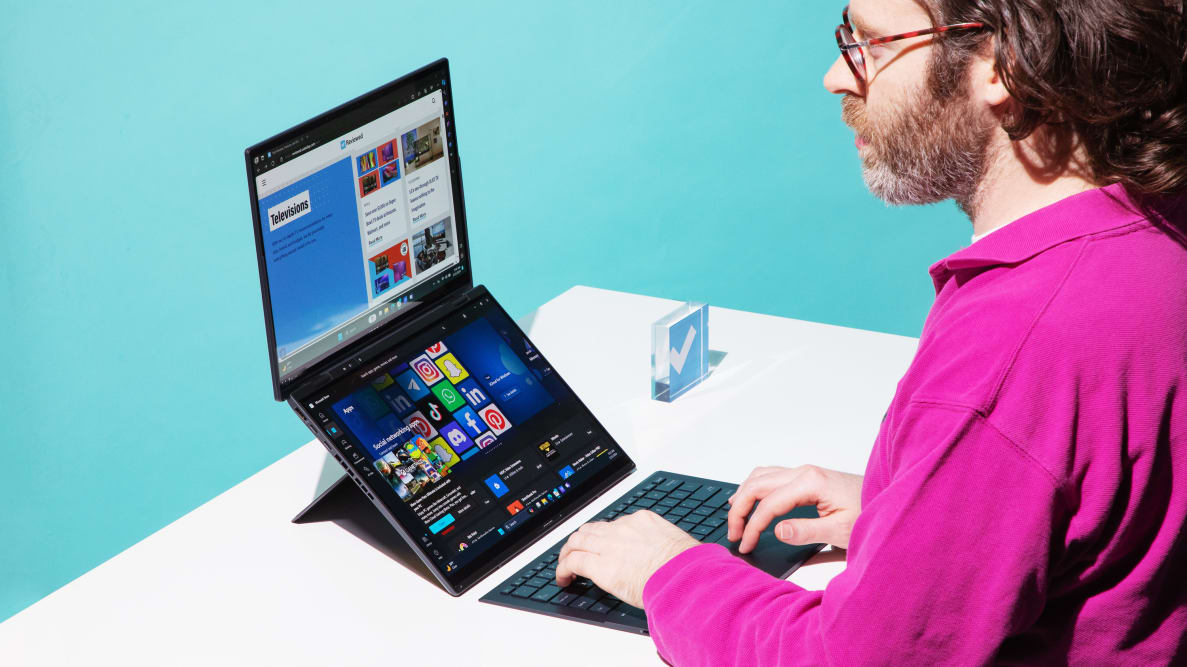Pros
-
Dual-screen concept works well
-
Can also pass as a “normal” laptop
-
Good value
Cons
-
Touchscreens don’t make it a tablet
-
Performance is modest for the price
-
Bluetooth keyboard can be finicky
About the Asus Zenbook Duo (2024)

The 2024 version of the Zenbook Duo includes a detachable Bluetooth keyboard, pressure-sensitive stylus, and an integrated kickstand.
The Zenbook Duo we tested is the entry-level Intel Core Ultra 7 155H model, which retails for $1,500. Asus offers an upgraded configuration with an Intel Core Ultra 9 185H processor, 32GB of RAM, and 3K OLED touchscreens (up from 1200p) for $1,700, although it isn’t available to purchase just yet at the time of writing. The upgraded model is arguably a better value, but the base specifications are fine for the price.
Asus also provides a detachable magnetic keyboard, an active stylus (the Asus Pen 2.0), a backpack, and a folding cardboard stand with every Zenbook Duo. The stand is a bit pointless, but the other accessories are essential, and I appreciate that Asus includes them with every Duo instead of charging extra.
The 2024 Zenbook Duo isn’t the first laptop to carry the line’s name, or one similar to it, but prior models differed significantly in design. The 2023 Duo and Zenbook Pro models had a smaller 16:10 touchscreen placed above the keyboard, which moved downwards to the chassis’s edge, and the touchpad was shunted to the right-hand side to make space. That design required more compromises than the new Zenbook Duo, which retains a full-sized keyboard and touchpad.
Asus Zenbook Duo (2024) specs
- Price as configured: $1,500
- Processor: Intel Core Ultra 7 155H, 16 cores, 22 threads, boost clock up to 4.8GHz
- Graphics: Intel Arc integrated graphics
- RAM: 16GB LPDDR5X 7467 MHz
- Storage: 1TB M.2 NVMe PCIe 4.0 solid state drive
- Display: Dual displays, 2x 14-inch 1,920 x 1,200 OLED 60Hz, both support touch
- Wireless connectivity: Wi-Fi 6E, Bluetooth 5.3
- Ports: 2x Thunderbolt 4 (USB-C) with DisplayPort out and Power Delivery, 1x USB-A 3.2 Gen 1, 1x HDMI 2.1, 1x 3.5mm combo audio jack
- Battery: 75WHrs
- Camera: 1080p webcam with IR camera for Windows Hello facial recognition login
- Weight: 3.64 pounds (1.65 kilograms)
- Dimensions: 12.34 x 8.58 x .78 inches
- Special features: Integrated kickstand, detachable keyboard, active stylus, included carrying case
- Warranty: 1-year limited laptop warranty
What we like
The dual displays deliver maximum screen space

The side-by-side dual screens allow users to surf, stream or type in multiple windows at once.
The Asus Zenbook Duo provides what it says on the tin: a dual-display design that proves two screens are indeed better than one. The innovative dual-display design features two 14-inch OLED screens which, when fully utilized, provide an experience akin to using a single 20-inch, 4:3 display. These can be stacked, with one above the other, or side-by-side with each screen rotated vertically, depending on your preferences and the apps you’re working with.
The stacked mode is great if you want to use one display for most productivity work while keeping tabs on extra information. It was perfect for keeping tabs on Slack and Threads while writing and worked equally well while dungeon-mastering a tabletop role-playing game.
The side-by-side mode is better for researching documents or editing videos. I used it while writing this review: Google Docs was open on the left display, while Asus’ specifications and the Reviewed laptop testing guide were kept to the right.
The built-in kickstand complements the design. The sturdy construction ensures stability in both display modes and, because it’s integrated into the bottom of the 2-in-1 instead of detachable, there’s no risk of it detaching or collapsing. The kickstand supports both the stacked and side-by-side configuration, though it works better when stacked as the side-by-side orientation doesn’t provide adjustment for the tilt of the display and feels a bit wobbly.
Whether these extra modes are useful for you will have everything to do with the apps you use. If you just want a device to browse the web, watch YouTube, and read emails, the dual-display design offers little advantage. But if you often use multiple windows at once and feel a typical laptop display is just too dang small even on a 16-inch machine, you’ll like the Zenbook Duo.
It’s also a normal laptop

The magnetic keyboard attaches over the bottom screen via pogo pins for a zero-latency connection.
Though the Zenbook Duo’s dual displays are eye-catching, the device also works well as a normal laptop. That’s important because there’s a good chance you’ll use it like a normal laptop at least as often as you take advantage of the dual displays.
The detachable keyboard attaches magnetically to the lower display, covering it and converting the space to a physical keyboard. The keyboard sits snugly on the lower screen and the layout is spacious. Key travel is substantial, and while I noticed more keyboard flex than ideal, each key stopped with a definitive bottoming out. The keyboard is backlit, too.
The touchpad is also good. It’s fairly spacious, measuring about five-and-a-half inches wide by three inches deep, and has a smooth, responsive feel. There is plenty of space to rest my palms, which isn’t true of folding-screen 2-in-1s like the Lenovo ThinkPad X1 Fold 16 and (to a lesser degree) the Asus Zenbook 17 Fold.
The displays are beautiful
If you’re going to have two displays, they have to be good. And the Zenbook Duo’s displays are very good, even in the more affordable configuration I reviewed.
The base Zenbook Duo has two identical 1920 x 1200, 16:10 OLED displays with a refresh rate of 60Hz. Those specifications won’t set anyone’s hair on fire, but they’re more than adequate for a 14-inch display. Would 1440p or 4K resolution look sharper? A bit. But at this size, the differences between 1080p and 4K are much less noticeable. The dual 1920 x 1200 OLED displays pack 161 pixels per inch (ppi), just two ppi less than a 27-inch 4K monitor. The brightness of both displays can be adjusted together or independently.
If you want a higher display resolution, you can step up to Zenbook Duo’s top configuration for $1,700, which has a pair of 2880 x 1800 OLED displays and ups pixel density to 242 ppi. I wouldn’t recommend the upgrade to everyone, but it could make sense for photographers and video editors.
Both displays have the signature vibrant color and realistic contrast OLED is known for, thanks to the ability of each pixel to turn all the way off when not in use, creating perfect black levels. Photos, movies, and games look punchy and saturated. The displays are very glossy, though, and I recorded a modest maximum brightness of 356 nits. Because of this, the Duo can be a tad uncomfortable to view outdoors or near a bright, sunlit window.
It’s weird, but the price makes sense

There may be a bit of a learning curve while getting used to the 2-in-1 design.
The Zenbook Duo is a weird, experimental 2-in-1, but you might not know it from the price.
That’s not to say it’s cheap at $1,500. Still, you’re getting a lot for your money. The Duo has two displays and a detachable, wireless keyboard with its own built-in battery.
And the Zenbook Duo’s price is right in line with similar contemporary alternatives including the Apple MacBook Air M3, Acer Swift Go 14 OLED, or Lenovo ThinkPad ThinkPad T14s.
That’s important. The Zenbook Duo isn’t just for PC nerds and gadget gurus who want the latest, strangest tech. It’s a mainstream alternative to a conventional laptop or 2-in-1 with a single display.
What we don’t like
It’s definitely not a tablet

Though the Zenbook Duo can lay completely flat, at 3.64 pounds, it's far too heavy to replace a traditional tablet.
PCs with touchscreens and versatile designs are often called 2-in-1s, which usually means the device can be used as both a PC or a tablet. I think the 2024 Zenbook Duo also qualifies as a 2-in-1, since it offers multiple ways to use the device, but it doesn’t work as a tablet.
The hinge allows 180 degrees of rotation, so it’s possible to lay the displays flat, but the device is too heavy and large to hold like that for more than a few minutes. Asus also provides a pressure-sensitive pen for stylus input, and it can be useful. I think most people hoping to use it as a larger digital canvas will be disappointed, as the size of the device can make it awkward to place on a desk and the hinge between the displays gets in the way and prevents it from being used as one giant canvas.
Asus compensates for these shortcomings with what it calls “Dual Screen Mode with Virtual Keyboard.” In this mode, the 2-in-1 is held like a laptop, but the physical keyboard isn’t attached. Instead, you’re free to use the lower touchscreen to summon a virtual keyboard with a multi-touch gesture. Think of it like a tablet with a kickstand and bonus secondary touchscreen.
That mode in some ways functions like a tablet, as it offers immediate access to a large, responsive touchscreen. Yet it didn’t replicate the same instant gratification because it’s too heavy to just pick up and use for more than a moment. It’s also not a great fit for tight spaces (like an airplane’s tray table) where a tablet excels. The Duo might have two touchscreens, but it’s no easier to use on-the-go than an average 14-inch laptop.
Performance is just ok for the price
The Zenbook Duo I reviewed had Intel’s Core Ultra 7 155H, a 16-core, 22-thread processor with a maximum turbo boost of up to 4.8 GHz. It also had 16GB of RAM and a 1TB PCIe gen 4.0 solid-state drive. It’s a capable system, but not the fastest available for $1,500.
Geekbench 6 proved that with a single-core score of 2,355 and a multi-core score of 9,038. That’s not bad, but many similarly priced laptops are quicker. Apple’s MacBook Air M2 scored 2,628 and 10,013, respectively, while the $1,300 Gigabyte Aero 14 OLED scored 2,333 and 11,880.
Results in other CPU-heavy benchmarks follow this trend. The Zenbook Duo isn’t slow, but it’s not especially fast. It can handle a wide variety of tasks including digital art, large spreadsheets, PDFs, coding, and so on. But demanding users will find the Zenbook Duo’s limits.
The Duo’s graphics performance holds up better, though it depends on your perspective. Asus uses Intel Arc integrated graphics, which might not sound impressive but Intel Arc represents a big upgrade over last generation’s Intel Xe graphics.
3DMark Night Raid proves the point. The Zenbook Duo achieved a score of 18,972. That handily beats the Lenovo IdeaPad Slim 3i 15 with Intel Iris Xe graphics, which achieved 13,726. That’s a nearly 40 percent uptick, which is more than enough to see a meaningful difference in the real world. A game that averaged 25 frames per second (fps) on Iris Xe can now hit 30fps or above; a game that hit 45 or 50fps can now reach 60 or higher.
Asus offers a more powerful Zenbook Duo configuration with Intel Core Ultra 9 processor, but I don’t expect it to radically change the performance equation. It will improve processor performance but increases the price to $1,700, and the Duo will still be a step behind its quickest competitors.
To be fair, the Zenbook Duo has a second display, and most competitors don’t. That’s obviously the reason for its modest bang per buck. Still, it’s a limitation to keep in mind. The Duo is great for multi-tasking, but less so if you want to multitask 4K video editing alongside 30 browser tabs.
The keyboard is finicky

Although it's a great feature to include, the detachable keyboard itself isn't without flaws.
As mentioned earlier, the Zenbook Duo’s keyboard is detachable and, when attached, grips the lower display magnetically. A set of pogo pens on the Duo’s lower lip provides a latency-free wired connection when the keyboard is set on top of the lower display, but it otherwise connects over Bluetooth.
Bluetooth works rather well these days, but it’s not perfect. I noticed a delay when opening the Duo to quickly check an email. The keyboard often wasn’t ready when the screen turned on, and though usually detected in just a few seconds, it occasionally took 15 to 30 seconds to connect.
I also noticed quirks when adding and removing the keyboard atop the second display, or when opening the Duo without it. The laptop sometimes failed to detect the keyboard’s physical presence, which meant it wouldn’t activate the keyboard or, in other cases, turn off the display it now covered. That forced me to manually activate or deactivate the second screen. Both problems were uncommon, but annoying.
Should you buy the Asus Zenbook Duo (2024)?
Maybe, if you think two screens are better than one

The 2024 Zenbook Duo works surprisingly well and for users who need it, provides ample monitor space on the go.
Make no mistake: the Zenbook is, and will always be, an experiment. It’s unlikely that dual-screen laptops like the Duo will dominate in the near future. That implies some risk for shoppers looking to buy the Duo. Maybe next year’s version will be far better, as the leap from the 2023 to the 2024 model demonstrates. Or maybe Asus will drop the whole idea.
If you’re ok with that risk, the Zenbook Duo is compelling. It delivers the promise of a dual-screen laptop by stuffing tons of display real estate into a footprint hardly larger than a typical 14-inch laptop. And Asus delivers on that promise at a reasonable price.
Lenovo’s Yoga Book 9i is the Zenbook Duo’s only direct competitor. It’s even more versatile thanks to a detachable keyboard stand and 360-degree hinge, but also has a keyboard that occupies just half the lower display and doesn’t provide a physical touchpad. The Lenovo is more expensive too, with a retail price of over $2,000.
That puts Asus in a comfortable spot. The Lenovo is better if you want the dual touchscreens to work more like a tablet or giant canvas, but Asus’s design is more practical and comfortable. It feels like a wild concept from the future when you want it to, but can pass as a normal 14-inch laptop when you don’t.

The 2024 Asus Zenbook Duo is an innovative dual-display laptop that fulfills its core promises without breaking the bank.
Meet the tester
Matthew S. Smith is a veteran tech journalist and general-purpose PC hardware nerd. Formerly the Lead Editor of Reviews at Digital Trends, he has over a decade of experience covering PC hardware. Matt often flies the virtual skies in Microsoft Flight Simulator and is on a quest to grow the perfect heirloom tomato.
Checking our work.
Our team is here to help you buy the best stuff and love what you own. Our writers, editors, and experts obsess over the products we cover to make sure you're confident and satisfied. Have a different opinion about something we recommend? Email us and we'll compare notes.
Shoot us an email



